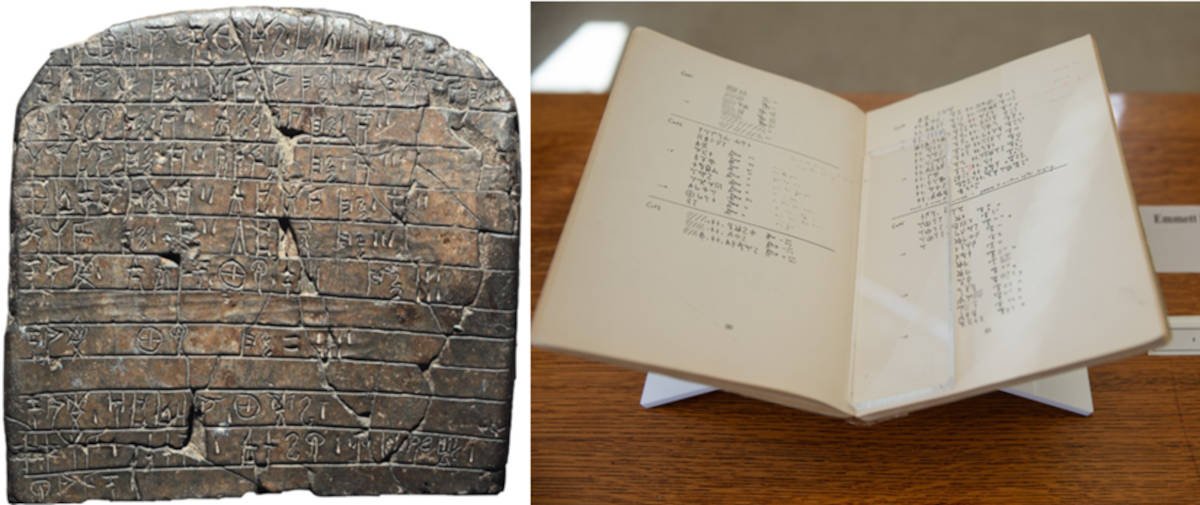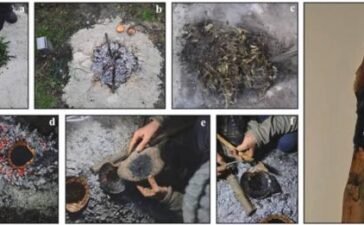By Michael Miller/University of Cincinatti
A retired Classics professor from Texas donated a collection of papers to the University of Cincinnati detailing the deciphering of an ancient Greek language that baffled generations of scholars. University of Texas at Austin Professor Emeritus Thomas Palaima donated boxes of documents, correspondence, files and photos chronicling the coordinated effort to translate the script called Linear B used in the Mycenaean language.
“I’m delighted these invaluable materials have found a home in UC Classics,” said Sean Gurd, chairman of the Department of Classics at the University of Texas at Austin.
“UC’s Classics archive may actually be the best classics-specific research library in the world, and I’ve worked in most of them.”
Linear B dates back to 1400 BC and predates Greek by several centuries. Scholars for decades were stymied in understanding and translating its symbols. “Deciphering Linear B has been called the Mount Everest of Greek archaeology. It was an enigma that captured the imaginations of many scholars,” said Jeff Kramer, a junior research associate and archivist in UC’s Department of Classics.

Jeff Kramer, a junior research associate and archivist in UC’s Department of Classics, talks about the collection of photos, letters and documents on Linear B that University of Texas at Austin Professor Thomas Palaima donated to UC. (Photo/Andrew Higley/UC Marketing)
Archaeologists found the first inscriptions for Linear B at Crete in 1900. Famed UC Classics Professor Carl Blegen added to this foundation when he discovered more than 600 tablets inscribed with Linear B while excavating at Pylos, Greece, in 1939. Blegen is best known for his excavations at the ancient city of Troy and his work in Greece unearthing the Palace of Nestor, the center of Mycenaean culture in the Bronze Age. But his discovery of the tablets proved invaluable in understanding Linear B. “It was really with Blegen’s finding so many tablets that they were able to decipher the language,” Kramer said.
You could see all the imperfections and all those human things that made it really intimate contact with someone from 1170 BC. The international translation effort began in earnest with Brooklyn College Professor Alice Kober, who for years worked with UC Classics graduate Emmett Bennett Jr., a student of Blegen’s, in a bid to understand the language. Their work coincided with a world fascination with codes and code-breaking during World War II. Bennett worked as a cryptographer for the Allies, tasked with translating coded messages from Japan.
“Right after World War II, you had a lot of code-breakers who had training relevant to this task,” Kramer said.

Book of decipherment notes. The mystery of the script Linear B would captivate scholars for generations. (Photo/Andrew Higley/UC Marketing)
Decoding a 3,500-year-old language using written symbols alone was a challenge worthy of any linguist or academic. There is an earlier version of this Greek script called Linear A that is still undeciphered largely because of how few examples of that text remain.
In the days long before spreadsheet software, Brooklyn College’s Kober worked to catalog the symbols individually by their frequency and juxtaposition to other characters on index cards she kept in dozens of old cigarette boxes. She amassed 180,000 such records now on file in UC’s Classics archives. Through her painstaking analysis, she discovered that the endings of lines of Linear B were consistently different, suggesting a change in the form of a word as many languages today do with plurals or vowels that reflect gender. Kramer said these are called declensions.
Meanwhile, Kober and Bennett also corresponded with an English architect who had both a knack for languages and an obsession with cracking Linear B. Like Kober, architect Michael Ventris spoke numerous languages and in his spare time put together a grid associating the symbols with consonants and vowels. Sadly, Kober’s work was cut short by her untimely death from illness in 1950. But both Palaima and Kramer are convinced she was close to making a critical breakthrough on Linear B.

Brooklyn College scholar Alice Kober catalogued individual symbols found in Linear B and identified both their frequency in the tablets and their juxtaposition to other symbols. She stored the notecards — more than 180,000 of them — in old cigarette boxes. (Photo/Andrew Higley/UC Marketing)
Instead, it was Ventris and his research partner John Chadwick, another former code-breaker at England’s top-secret Bletchley Park, who discovered in 1952 that Linear B is a form of Greek and provided the first published translation. “Kober and Bennett built the staircase that Ventris ascended,” UC’s Kramer said. “He didn’t build any of the risers or steps, but he did take the final steps that Kober may have taken if she had lived.”
Ventris also died an untimely death in a car accident in 1956. He was just 34.
Bennett was awarded a gold medal from the Archaeological Institute of America for his work with Linear B, among other contributions. Three other UC luminaries, all faculty, have won this prestigious award: Blegen, John “Jack” Caskey and UC Professor Emeritus Jack Davis. During his career, Bennett launched the bibliographic journal Nestor, now edited by UC Classics’ Junior Research Associate Carol Hershenson. Bennett died in 2011. He was Palaima’s mentor and lifelong friend and the namesake to Palaima’s son.
“We had kindred senses of humor,” Palaima said. “I learned everything I know from him.”
So what do the tablets say?
Palaima said they were mostly business records on international trade networks, imports and exports and other goods and services.
“They don’t write histories or poetry. They don’t send letters,” Palaima said.
“These are records that keep track of who’s doing what, where and how they’re doing it,” Palaima said. “We see a lot of feasting texts for gods and lots of names for chariots, armor and animals. How many sheep. Who owns the flocks. What shepherds are on duty. And how many are available for the next feast.”
Palaima visited UC’s Department of Classics this month where he gave talks on Kober’s contribution to Linear B and the collection he donated to UC.
For his dissertation, Palaima pored over the excavation notebooks of Blegen and others at Pylos to extract and compile information about the Linear B tablets and their archaeological contexts. He was awarded a Fulbright scholarship to study in Athens.
“I’d pick up the clay tablets and put my fingers where the scribe’s fingers were 3,500 years ago,” he said. “I could identify the scribes who wrote them. You could see all the imperfections and all those human things that made it really intimate contact with someone from 1170 B.C.”
Palaima was recognized with a Genius Grant as a MacArthur fellow for his contribution to our understanding of the Bronze Age.
He said he is pleased that his collection will provide future scholars with the records and letters that help tell this important story at a place that contributed so much to its discovery.
“It’s sort of like this stuff is coming home. UC Classics is the greatest program to study the Mediterranean Bronze Age,” Palaima said.
Top image: The script Linear B appears on a clay tablet, one of more than 600 that UC Classics Professor Carl Blegen discovered in 1939 while working on excavations at Pylos, Greece. Photo/UC Classics
The article, ‘Archive Tells of Cracking Ancient Greek Language’ by Michael Miller is a press release by the University of Cincinatti.






